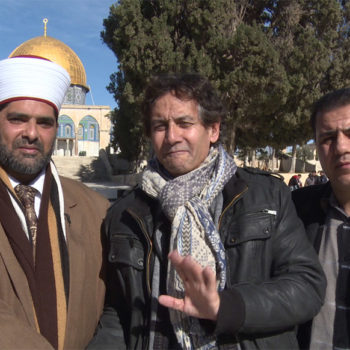Inspired by Aliza Davidovit’s article in Lifestyles Magazine (abstracts)
Vive la France is not a choice chant for most Jews who have sadly witnessed that country’s recurrent and blatant antisemitism. Still, it is hard not to love the seductive France that intoxicates the heart and mind with fantasies of romance-it is harder yet if you’re a woman with an affinity for men who hold the door open, who rise when you excuse yourself from the table, who make you feel like you’re the most beautiful woman in the room, and who, in an age of feminism, still appreciate the feminine. Pierre Rehov is one such Frenchman. But his intrigue goes beyond the stereotypical charms. For although there are many who would love to love him, there are even more who would love to kill him.
For Pierre Rehov, life only took on true meaning when he began putting it at risk. He had been a movie producer, a novelist, a journalist and a lawyer. But none of those professions satisfied his searching soul. In moments of deep personal introspection he questioned himself, “Who and what am I really?” For him, the answer came when he turned on the news on October 6, 2000, and saw the images of the shooting of Mohammed al-Dura, the 12 year-old Palestinian boy, whom Israel was summarily accused of targeting. “I was in shock,” says Rehov, who rarely watches the pro-Arab French broadcasts. “In this case, I knew as a producer that there was something very fishy about the images. The angles just weren’t right.”
The day after al-Dura was shot, there was a pro-Palestinian rally in the streets of Paris, where the participants screamed, “Death to the Jews.” Rehov was reminded of one century ago when the exact same antisemitic scene played itself out on the streets of Paris prompted by the Alfred Dreyfus trial. Rehov’s instincts told him that the death of Mohammed al-Dura was another blood libel against the Jews. “I knew that I was no Herzl, but I had to do something,” Rehov says.
Pierre Rehov was born in Algeria where his ancestors had lived for almost 500 years. He and his family left for France in 1961 with 250,000 other Jewish refugees who were expelled from the newly Muslim-ruled territory. Rehov was 6 years old when he found out that he was Jewish-after seeing graffiti on the wall of his building where he and his family lived. The graffiti read, “The French in the boat; the Arabs in a castle; and the Jews to be exterminated.”
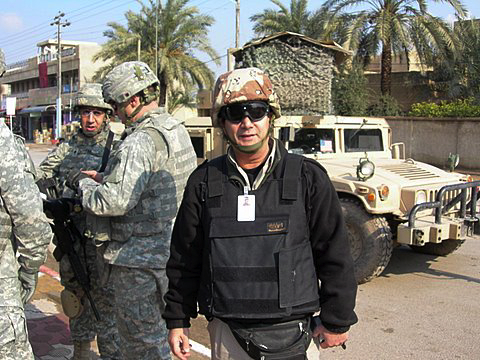
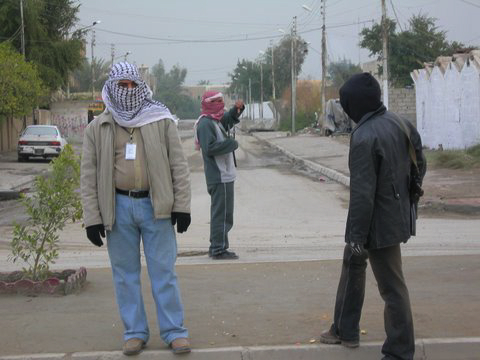
Living in Algeria, the young boy knew very well what “French” and “Arab” meant, but the other word was new to him. Turning to his father, who was a well liked and respected dentist, he asked, “What is a Jew?” His father explained that Jews were a very different group of people who were always treated badly by the rest of the population and a people who would always have troubles. He then told little Pierre that he was a Jew. It was not long after Rehov told his classmates that he was Jewish that they began to call him un sale juif-a dirty Jew. Other kids would also praise the works of Hitler.
If only words were the worst type of hate that Rehov experienced, he would have gotten over it. But as a child, in Algeria, he observed hatred in its most evil manifestation-terrorism. He’ll never forget the day he and his father were about to enter a café when a grenade, tossed by Muslim extremists rebelling against French rule, exploded. He saw people exiting drenched in blood and without limbs, some people didn’t exit at all. His father grabbed him in his arms and they ran. Another explosive incident happened at his own school where 11 of his classmates were killed. “I saw the worst images of my life as a child,” Rehov says.
So at 9 years old, Rehov, his mother, and younger brother left Algeria to join his father already in France, all hoping for a better and calmer life. But the French refugees were hardly met with open arms by the native French who displayed great antipathy toward the influx of Algerian immigrants. “It was ironic that we were kicked out of Algeria by the Muslims because we were French, yet we were treated so poorly by the French themselves.”
“In those days nobody said ‘Palestinians,’” Rehov recalls. “They were called ‘Arabs.’ They only later became “Palestinians” as a political ploy against Israel.” He remembers telling the story of Napoleon who, upon passing a synagogue during the Ninth of Av (a day of mourning), looked inside and saw Jews sitting on the floor and weeping. When he inquired further, he was told the Jews were mourning over the destruction of their Holy Temple. “How long ago did this occur?” Napoleon asked. “About 1,500 years ago,” he was told. “In that case there is no doubt that their Temple will be rebuilt,” Napoleon said. “A people capable of crying for so long over its destroyed temple and land will eventually find its way home.”
Rehov feels that Jews have cried long enough, and now that they have their homeland once again they must do whatever it takes to protect it. “I believe that Israel is the miracle of the 20th century,” Rehov says. “It is also the result of the worse injustice that has ever been visited upon a people. No other people but the Jews have been exterminated, non-stop, for 20 centuries.” He cautions fellow Jews by reminding them how 470,000 Jews were deported from the Warsaw Ghetto before the remaining the 30,000 realized what was happening and decided to put up a resistance. “How many Jews are going to be killed before we wake up and decide to fight back?” Rehov questions passionately. “I don’t want to be among the last 30,000 to start fighting. I’m starting to fight right now.”
And so after the shooting of Mohamed al-Dura and the antisemitic rallies that ensued, Pierre Rehov took his fight off the streets of Paris to the courts of France. He rallied Jewish organizations in France to join him in a lawsuit against the French government for its defamation of the State of Israel. Rehov, who also holds an Israeli passport, was then off to the Holy Land to investigate the circumstance surrounding the tragic, yet suspicious death of al-Dura. His own research, an IDF investigation, and the sources he interviewed, revealed that the trajectory of Israeli gunfire and the position of the bullet holes were inconsistent. Other inconsistencies were enumerated as well. Al-Dura was buried before any autopsy could be performed. Rehov’s investigations, however, had satisfied his suspicion that it was the Palestinians themselves who killed al-Dura for propaganda purposes. “It is not so hard to believe from some of these extremists who indoctrinate their children to be martyrs and suicide bombers,” he says. When Rehov returned to France, he found out that the defamation case had been dismissed after only six weeks, with no explanation. Rehov says it usually takes two years for a case to be dismissed in France.
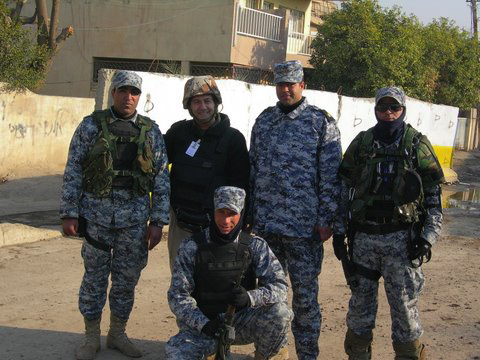
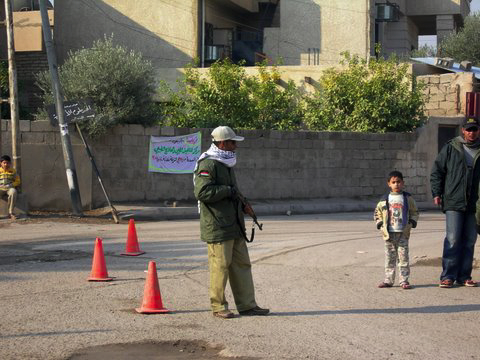
But Rehov’s resolve could not be dismissed. With his French passport, Arabic features, and a digital recorder, he went into the territories (which are forbidden to Israeli citizens) posing as a French tourist and began an undercover investigation of what is really going on behind the scenes. He has thus far produced six documentaries from the “tourist attractions” he visited in the territories: A War of Images, which reveals shocking images of incitement displayed on Yasser Arafat’s Palestinian Television network; The Trojan Horse, which betrays Arafat’s true intentions and shows rare footage of Palestinian leaders advocating the eradication of the Jewish state and the extermination of the Jewish people, and his film The Holy Land: Christians in Peril, which exposes the true story behind the Church of Nativity confrontation and reveals the dangers for Christians living under Islamic rule, he then filmed The Road to Jenin, that shows there was no massacre in Jenin, as some Palestinians claimed. Silent Exodus, which tells the little known story of the plight of the million Jews who had to leave the Muslim countries their families had lived in for centuries. Hostages of Hatred, that gives all the real data about the Palestinian refugees, a question that is not as well known as it might be imagined.
But, in France, the country that prides itself on the tripartite philosophy Liberté (liberty), Egalité (equality), et Fraternité (brotherhood), not one news channel agreed to air them. So he contrived another way to get his tapes seen. Because of France’s freedom of expression laws, newsstands have to carry publications no matter what their point of view. So Rehov created a political magazine entitled Contre Champs, and affixed a VHS copy of his documentary to each magazine. 50,000 copies have been sold of the first two issues.
Indeed Pierre Rehov will leave no stone unturned when it comes to exposing Arafat and his cohorts. His main goal? Finding a real path to peace, where two people will finally be able to live beside each other, in two free and independent States.
To reach that goal, says Rehov, the first step is to educate the media and the new generations… Since it is almost impossible for a reporter to work freely in the Territories, or to report honestly without risking his life.
PIERRE REHOV The Lion In Exile
By Dr Phyllis Chesler
Pierre Rehov, a nom de guerre, is indeed a resistance fighter; he resists the Islamist propaganda wars against Israel, the Jews, and the West by making films that document the truth.
He is the documentarian of the Al-Aqsa intifada; the filmmaker who showed us what Jenin was really about (“The Road to Jenin”) and who the suicide bombers really are (“Suicide Killers”). Early on, in “The Silent Exodus,” Rehov documented the story of Arab and North African Jews who were forced to flee their homelands. And in “The Trojan Horse/Holy Land: Christians in Peril,” he detailed the persecution of Christians in the Islamist Middle East.
Rehov, a North African (Algerian) Jew who fled his homeland for France in 1961, is not just an armchair observer. His weapon is his camera, which he takes with him into dangerous war zones. I have known him for five years now and am proud to have championed his documentaries by posting them on my website in 2004. At the time, more than 30,000 people viewed two of his films in five weeks. Now, thankfully, his many films are available for sale at his own website (www.pierrerehov.com).
Last month I unexpectedly ran into Rehov at a luncheon in Manhattan. I asked him how long he would be visiting the U.S. His answer startled me. He said he was here to stay, that he could no longer live in Paris, that the very air there had become poisoned with anti-Israel sentiment, and that his pro-Israel activism had led to unending legal and financial problems for himself and for other pro-Israel activists.
While living in France, Rehov was a novelist and a magazine publisher. His business ventures took him everywhere, including Morocco. In the mid-1990s, he was sharing a very friendly, at-home dinner with a Moroccan Muslim business client and his wife when the man, albeit under the influence, suddenly began weeping uncontrollably and told him, “You’re a really nice guy but you’re a Jew, and I know that one day I will have to kill you.”
We are talking about a secular Muslim, a sophisticated individual – politics was not being discussed, nor was Israel or Judaism. Yet out of such alcoholic depths warriors sometimes spring.
That was a turning point for Rehov. He vowed not to remain a bystander or appeaser.
When the intifada of 2000 broke out, he was ready. He was the first person who challenged the Al-Dura blood libel. The horrific, faked murder of a Palestinian child was first aired on and promoted globally by France’s Channel Two. Rehov sued Channel Two; he even persuaded the French B’nai Brith to back his lawsuit. He spent eight months researching the matter, only to see his case dismissed in six weeks.
Philippe Karsenty, another hero, was sued by Channel Two for defamation because he, too, continued to insist that the Al Dura killing was a hoax. Had Karsenty lost, he could have been jailed. After seven hard years, Karsenty was finally vindicated in a French court – a victory Channel Two is still appealing.
Israel was demonized all over the world in the wake of the alleged Al Dura murder. Rehov tried to rally French Jewish organizations to hold the French government legally responsible for having defamed the Jewish state. (Channel Two is a government-owned station). He went to Israel (he holds an Israeli passport) to look into the case. A German filmmaker, Esther Schapira, made a documentary in which she raised all the issues. Rehov persuaded a Jewish organization to buy the rights so that the film could be widely distributed.
The Israeli government and most Jewish organizations preferred not to make a fuss. Perhaps they hoped the world would just forget the Al Dura blood libel. That did not stop Rehov. French passport in hand, he assembled a crew and took his digital camera to extremely dangerous places in the West Bank and Gaza.
In one film after the other, he exposed the Palestinian propaganda-and-hate machine, documenting, among other issues, the truth about the Palestinian refugees, the abuse of Jews in Arab lands and the persecution of Christians in the disputed territories and the Muslim world, and the real stories of the Palestinian takeover of the Church of the Nativity and the non-massacre in Jenin.
But he could not persuade a single station in France to show any of his films. (I myself failed to interest HBO and PBS in airing his films in the U.S., though both have aired films with very opposite points of view). So Rehov ingeniously used French freedom of expression laws in order to distribute his films. He created a political magazine he called Contre Champs (Reverse Angle), and inserted a copy of his documentaries in each issue. The magazines sold like hotcakes.
He is now working on a new film script – not a documentary this time but a feature film. If he can get it produced, it may indeed influence the course of events. I can say no more about it at this time
I mentioned to Rehov my fear that America was undergoing the same Islamification process – albeit at a slower, more subtle pace – that had convinced him it was time to leave France, and that it remains to be seen whether we will be strong enough to stand up to it.
He responded, “I am afraid that no one will understand this until there is another terrorist attack on American soil.”
Said I, mournfully: “That might wake up the Christians, but not the Jews.”
